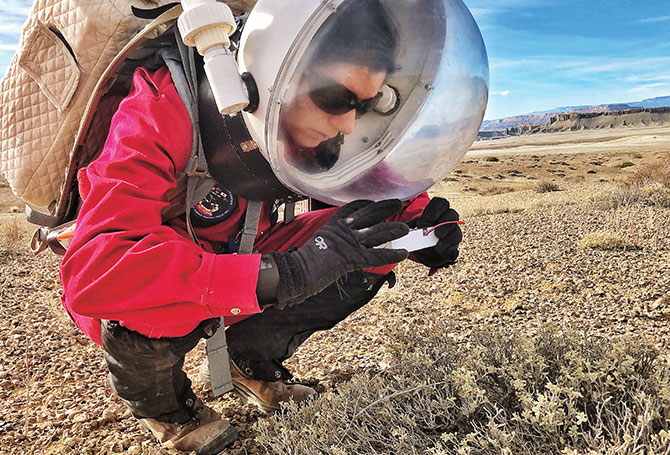Julia DeMarines: A real-life Ellie Arroway who wants to “watch the stars, and see [herself] running with them”
By Rabeea Rasheed
Learning about the cosmic perspective and our seemingly insignificant, yet rare and beautiful place in the universe, makes one think, are there any others out there? Are we alone in the cosmos? These questions are a matter of interest for a lot of humans, but they’ve become a lifelong passion for Julia DeMarines. She’s seeking answers to these questions with help from her extensive academic career and diligent research work. Julia is an astrobiologist, National Geographic Explorer, radio astronomer, and a science communicator based in Oakland, California.
In her young life, Julia recounts that she was fortunate enough to have a little planetarium at her school as getting a clear view of the stars from the middle of the city was almost impossible. As a child, visiting the school planetarium truly changed her life as she was awestruck to see numerous stars for the first time in her life. She was immediately engrossed with the idea and her parents were paying close attention to her growing interest in space exploration. When she was just 13 years old, she watched the movie “Contact” upon her father’s recommendation. She was completely awestruck – she found that she was captivated by space and the big questions it raised. A film that inspired a generation of scientists also left a lasting impression on Julia. Most notably, she was completely blown away by that movie’s lead character: a woman searching for life in the Universe through radio astronomy. Watching “Contact” as a 13 year-old was when Julia decided upon taking up astronomy as an academic subject. Pursuing an undergraduate degree at the University of Colorado Boulder, she learned about astrobiology, the scientific quest to understand the nature of life , and she created the Astrobiology Club at her university in 2006.
Julia received her bachelor’s degree in astronomy with a minor in geology from the University of Colorado Boulder in 2010. She then went to France for her Master of Science in Space Studies from the International Space University (ISU) in 2011; Her master’s degree focused on life sciences, astrobiology, and astrosociology.

Julia is now a radio astronomer at Berkeley SETI, where she uses the Green Bank Telescope (GBT) to explore how an extraterrestrial civilization might perceive Earth through radio wavelengths. She is actively working on a project called ‘’Moon Bouncing” – using the GBT to look for transmissions from human technology reflected back to us by the Moon. Julia is showing us what Earth would look like at radio wavelengths if viewed by an extraterrestrial civilization. She wants to know what we look like or sound like as a communicating exoplanet.
Julia has a wide array of research experience on different topics: she has done research and presented on the topic of METI (messaging extraterrestrial intelligence) and, among other pursuits, has published her work in space policy journals. She was an intern at NASA Ames Research Center in 2011 and is now a research scientist at the Blue Marble Space Institute of Science. Additionally, she has been awarded multiple NASA grants.
Julia co-founded SAGANet (Social Action for a Grassroots Astrobiology Network) with five other colleagues in 2011. She also won a highly competitive National Geographic Grosvenor Teacher Fellowship with Lindblad Expeditions, where she went on an expedition to the Galapagos Islands. Julia has received numerous awards and recognition for her work as an educator and is active in science communication. She has also produced and hosted several of her own workshops dedicated to science outreach. Julia believes if you are an astrobiologist it’s impossible for you to not communicate your passion with others. She started a project in 2013, called ‘’Space in your face’’ – an educational event where her main objective is to make space science easy to understand and at the same entertaining for the participants. Her workshops feature a variety of skits, science lectures, cover songs, and much more.
By day, Julia inspires hundreds of students during her science workshops and helps them to understand the cosmic perspective and our place in the universe. By night, she looks for her childhood dream to come true and wonders if our pale blue dot is the only living planet in the universe.
BMSIS YSP Research Associate Rabeea Rasheed is working on the YSP project “Communicating Topics in Earth and Space Science”
Rabeea is a science communicator and educator at Lahore Grammar School in Pakistan. She is also International Committee member of NoR CEL.
